

群馬県立日本絹の里. English. The history of Nishijin weaving. Weaving : Nishijin Textiles. Nishijin weaving technique. Nishijin weaving has been famous in Japan for centuries for its detail and beauty.
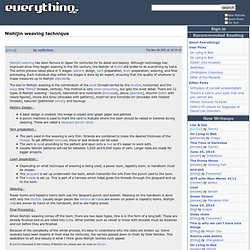
Although technology has improved since they began weaving in the 5th century, the Nishijin of Kyoto still prefer to do everything by hand. The entire process takes place in 5 stages: pattern design, yarn preparation, loom preparation, weaving, and final processing. Each individual step within the stages is done by an expert, ensuring that the quality of whatever is made measures up to Nishijin standards. The key to Nishijin weaving is the combination of the woof (thread carried by the shuttle, horizontal) and the warp (the "filling" threads, vertical).
This method is very time-consuming, but gets the most detail. Pattern Design :A basic design is created; the image is copied onto graph paper and painted.A punch machine is used to mark the card to indicate where the loom should be raised or lowered during weaving. Power looms and tapestry looms both use the Jacquard punch card system. Final Processing : Dyeing and Weaving. Weave (p. 103 ) 1.
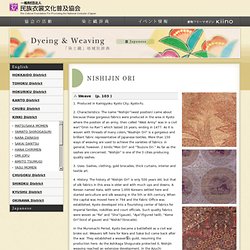
Produced in Kamigyoku Kyoto City, Kyoto-Fu. 2. Characteristics: The name "Nishijin"(west position) came about because these gorgeous fabrics were produced in the area in Kyoto where the position of an army, then called "West Army" was in a civil war("Onin no Ran") which lasted 10 years, ending in 1477. As it is woven with threads of many colors,"Nisahijin Ori" is a gorgeous and brilliant fabric representative of Japanese textiles. 3. 4.
In the Muromachi Period, Kyoto became a battlefield as a civil war broke out. Japan Living Arts by Steve Beimel. "Behind Paper Doors–a series about remarkable people in Kyoto.
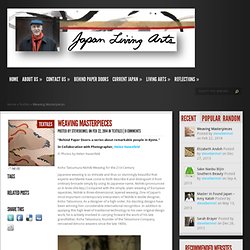
" In Collaboration with Photographer, Helen Hasenfeld © Photos by Helen Hasenfeld Koho Tatsumura Nishiki Weaving for the 21st Century Japanese weaving is so intricate and thus so stunningly beautiful that experts worldwide have come to both describe it and distinguish it from ordinary brocade simply by using its Japanese name, Nishiki (pronounced as in knee-she-key.) Compared with the simple, plain weaving of European tapestries, Nishiki is three-dimensional, layered weaving.
To this end, Koho established the “Japan Traditional Weaving Preservation Research Society,” for the purpose of researching exceptional pieces of ancient woven cloth and reconstructing the weaving techniques required to produce them. In its desire to revive ancient methods, Tatsumura explained how The Society began by looking at textile fragments and collaborating with Kyoto Dyeworks Research Center. Design layout created prior to weaving.
Woven Treasures Gallery Guide by The Textile Museum. Yunjin Brocade Master 1 (720p) Traditional Techniques: 絡み織り Karamiori. Karamiori (絡織り•搦み織り) Nara Period Clamp Resist Dyeing on RA 茶地鹿花卉文夾纈羅 Karamiori (絡織り•搦み織り), the tangling of threads to create nets and gauze-like fabrics, is a very old and highly respected form of textile production.
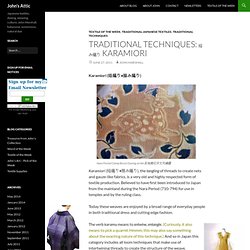
Believed to have first been introduced to Japan from the mainland during the Nara Period (710-794) for use in temples and by the ruling class. Elegantly simple karamiori haori for a summer's day. The dark color of the weave in contrast to the lighter-colored kimono beneath helps the wearer appear cool and refreshed. Today these weaves are enjoyed by a broad range of everyday people in both traditional dress and cutting edge fashion. Karamiori woven gown of pure gold. The verb karamu means to entwine, entangle. Many methods that fall under this Japanese category are called leno weaves. Manipulating the Warp Threads to Create Twists There is a wonderfully clear video clip on You-Tube by Patty Anne showing how a leno weave is created: It sure looks like a lot of work, doesn’t it?
The history of Nishijin weaving. Japan Living Arts by Steve Beimel. Dyeing and Weaving. Begin Japanology - Nishijin ori. Japanese Textiles. Meibutsugire are “famed fabrics” or “named fabrics” associated with the Tea Ceremony.
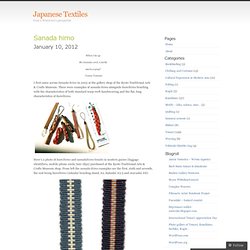
Fragments of incredibly valuable fabrics, very often of exotic origin and highly complex in terms of weaving structure, were patched together to form the pouches surrounding tea caddies. Such tea caddies were small ceramic containers with ivory lids and the fabric pouch (shifuku) was closed with a simple thin braided cord. As with other objects in the Tea Ceremony, the fabrics are designed to inspire conversation and admiration. They certainly represent the obsession of complex textiles among the Japanese; here they are recycled and preserved in aristocratic settings of luxury, not entirely different from the scrimping and saving of thread and fabric among peasants and farmers at the other end of the social spectrum. For me, they represent textiles earning a place of respect in the Tea Ceremony, alongside ironwork, ceramics, bamboo, calligraphy and paper – all the arts are thus represented. 1. 2. 3.